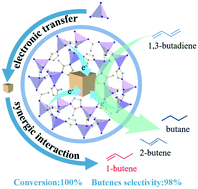Tuning the electronic property of Pd nanoparticles by encapsulation within ZIF-67 shells towards enhanced performance in 1,3-butadiene hydrogenation†
Abstract
The low olefin selectivity of Pd-based catalysts is a long-term challenge for the selective hydrogenation of 1,3-butadiene. Hybrid Pd/metal–organic framework (MOF) catalysts may help tackle this problem as they can stabilize Pd nanoparticles and regulate their electronic property. Herein, both surface-supported Pd/ZIF-67 and encapsulated Pd@ZIF-67 catalysts were prepared to explore the synergy between Pd and ZIF-67 and the structure–performance relationship of the catalysts. SEM and TEM reveal the different spatial positions of Pd on the two catalysts. Interestingly, encapsulated Pd@ZIF-67 shows excellent catalytic performance in the 40 h test, with a conversion of 100% and a butene selectivity of 98%, outperforming the surface-supported Pd/ZIF-67 catalyst. XPS, CO-IR and DFT calculations indicate that the encapsulated structure promotes the synergistic interaction between the ZIF-67 and Pd sites. Furthermore, in situ DRIFTS of 1-butene reveals that the enhanced synergistic interaction weakens the adsorption of 1-butene on the catalyst surface while inhibiting its isomerization and further hydrogenation. The presented strategy together with the mechanistic results clarify the relationship between the structure and the synergistic interaction and provide a promising approach for the application of synergistic interactions in hydrogenation catalysts.



 Please wait while we load your content...
Please wait while we load your content...